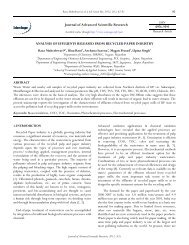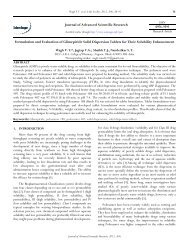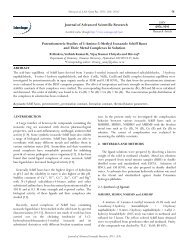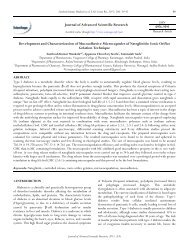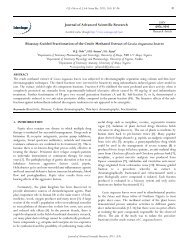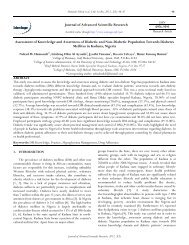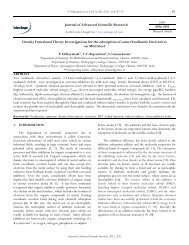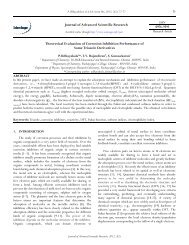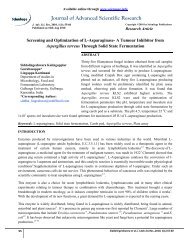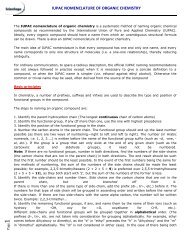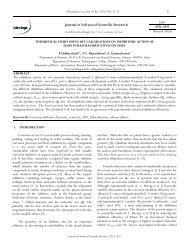Halloysite Nanotubes and Applications: A Review - Sciensage.info
Halloysite Nanotubes and Applications: A Review - Sciensage.info
Halloysite Nanotubes and Applications: A Review - Sciensage.info
Create successful ePaper yourself
Turn your PDF publications into a flip-book with our unique Google optimized e-Paper software.
Ravindra Kamble et al, J Adv Scient Res, 2012, 3(2): 25-29 25<br />
Journal of Advanced Scientific Research<br />
Available online through http://www.sciensage.<strong>info</strong>/jasr<br />
ISSN<br />
0976-9595<br />
<strong>Review</strong> Article<br />
<strong>Halloysite</strong> <strong>Nanotubes</strong> <strong>and</strong> <strong>Applications</strong>: A <strong>Review</strong><br />
Ravindra Kamble* 1 , Manasi Ghag 2 , Sheetal Gaikawad 1 , Bijoy Kumar P<strong>and</strong>a 3<br />
* 1 Department of Pharmaceutics, Poona College of Pharmacy, Bharati Vidyapeeth Deemed University, Pune, Maharashtra, India<br />
2<br />
Poona College of Pharmacy, Bharati Vidyapeeth Deemed University, Pune, Maharashtra, India<br />
3 Department of Clinical Pharmacy, Poona College of Pharmacy, Bharati Vidyapeeth Deemed University, Pune, Maharashtra, India<br />
*Corresponding author: kravi_73@rediffmail.com<br />
ABSTRACT<br />
Various successful results of nanotechnology like carbon nanotubes, nanofluids, nanoparticles, nano emulsions, nano capsules, etc<br />
are not considered to be safe for humans as well as for environment because of their toxicology potencies. <strong>Halloysite</strong> nanotubes are<br />
naturally occurring eco-friendly nanotubes with low cost that are harmless to human. <strong>Halloysite</strong> <strong>Nanotubes</strong> (HNTs) are unique <strong>and</strong><br />
versatile nanomaterials composed of double layered aluminosilicate minerals with a predominantly hollow tubular structure in<br />
submicron range. They are nontoxic in nature, have tuneable release rates <strong>and</strong> fast adsorption rates. These nanotubes have got wide<br />
range of applications in anticancer therapy, sustained delivery for certain agents, act as template or nanoreactor for biocatalyst, have<br />
found use in personal care <strong>and</strong> cosmetics <strong>and</strong> even used as environment protective.<br />
Keywords: <strong>Halloysite</strong> nanotubes, <strong>Applications</strong> of HNTs, <strong>Halloysite</strong> Cytotoxicity, Nanoreactor, biocatalyst.<br />
1. INTRODUCTION<br />
In the field of pharmacy <strong>and</strong> health care, effectiveness of<br />
medicine <strong>and</strong> therapy is very important, failure or drawback in<br />
the drug therapy may lead to either ineffectiveness or side<br />
effects which hamper human health. Green nanotechnology<br />
aims at developing environment safe <strong>and</strong> less harmful nano<br />
products. <strong>Halloysite</strong> clay nanotubes, nanocomposites, nano<br />
powders, etc are now emerging as trend setters in green<br />
nanotechnology. <strong>Halloysite</strong> nanotubes are eco friendly<br />
nanotubes with low cost than carbon nanotubes. In recent<br />
years there has been growing concern about the effect of<br />
carbon nanotubes on human health <strong>and</strong> on environment<br />
because of their potential toxic nature. <strong>Halloysite</strong> nanotubes<br />
find numerous commercial applications such as, additives in<br />
polymers <strong>and</strong> plastic, electronic components, drug delivery<br />
vehicles, cosmetics <strong>and</strong> in home <strong>and</strong> personal care products.<br />
(a)<br />
2. HALLOYSITE CLAY NANOTUBE [1, 2]<br />
Naturally formed in the Earth over millions of years,<br />
halloysite nanotubes are unique <strong>and</strong> versatile nanomaterials that<br />
composed of double layer of aluminium, silicon, hydrogen <strong>and</strong><br />
oxygen. <strong>Halloysite</strong> nanotubes are ultra-tiny hollow tubes with<br />
diameters typically smaller than 100 nanometres (100<br />
billionths of a meter), with lengths typically ranging from<br />
about 500 nanometres to over 1.2 microns (millionths of a<br />
meter). <strong>Halloysite</strong> nanotubes are formed as a result of strain<br />
caused by lattice mismatch between adjacent silicon dioxide<br />
<strong>and</strong> aluminium oxide layers.<br />
(b)<br />
Fig. 1: (a) SEM image of HNT, (b) a bundle of HNTs compared<br />
to the width of human hair<br />
2.1. Advantages of <strong>Halloysite</strong> <strong>Nanotubes</strong><br />
• Natural, non toxic, biocompatible <strong>and</strong> EPA 4A listed material<br />
• Fine particle size, high surface area <strong>and</strong> superb dispersion<br />
• High cation exchange capacity<br />
Journal of Advanced Scientific Research, 2012, 3(2)
• Maintains uniform, sustained release rates <strong>and</strong> no initial<br />
overdosage<br />
• Capable of prohibiting release unless triggered <strong>and</strong> tuneable<br />
release rates<br />
• Protects active agent within its lumen during harsh material<br />
processing<br />
• Capable of loading multiple active agents simultaneously<br />
• Reduces the volume of costly active agents<br />
• Implementable in many forms such as powders, creams, gels,<br />
lotions <strong>and</strong> sprays<br />
• Superior loading rates to other carriers, Fast adsorption rate<br />
<strong>and</strong> high adsorption capacity<br />
• High aspect ratio, high porosity <strong>and</strong> non swelling<br />
• Regeneration ability <strong>and</strong> increased efficacy<br />
2.2. Physical Properties [3]<br />
‣ <strong>Halloysite</strong> specifications (used in research studies)<br />
‣ Typical specific surface area - 65 m2/g<br />
‣ Pore volume ~ 1.25 mL/g<br />
‣ Refractive index - 1.54<br />
‣ Specific gravity - 2.53 g/cm3<br />
‣ Average tube diameter - 50 nm<br />
‣ Inner lumen diameter - 15 nm<br />
2.3. Electro-Chemical Properties [4]<br />
1. The outer surface of the halloysite nanotubes has properties<br />
similar to SiO 2 with negative charge at pH 6 – 7 (zeta<br />
potential) while the inner cylinder core is related to Al 2 O 3<br />
which is slightly positively charged.<br />
Ravindra Kamble et al, J Adv Scient Res, 2012, 3(2): 25-29 26<br />
Fig. 2: Chemical representation of HNT<br />
3. TYPES OF HALLOYSITE NANOTUBE [8,9]<br />
Two types of halloysite nanotubes models are developed<br />
for effective studies in field of nanotechnology.<br />
Single Walled Halloylsite Nanotube Model<br />
Multi Walled Halloylsite Nanotube Model<br />
2. The positive (below pH 8.5) charge of the inner lumen<br />
promotes loading of halloysite nanotubes with negative<br />
macromolecules within void spaces, which are at the same<br />
time repelled from the negatively charged outer surfaces.<br />
2.4. <strong>Halloysite</strong> Cytotoxicity <strong>and</strong> Cytocompability [5-7]<br />
The current research suggests that HNTs are not toxic for<br />
cells <strong>and</strong> those with 50 to 70 nm in external diameter, 15 nm<br />
diameter lumen <strong>and</strong> 1to 0.5 µm in length are chemically<br />
stable.<br />
2.5. Chemistry [8]<br />
<strong>Halloysite</strong> (Al 2 Si 2 O 5 (OH) 4 .2H 2 0) is chemically related to<br />
kaolin. HNTs contain two types of hydroxyl groups, inner <strong>and</strong><br />
outer hydroxyl groups, which are situated between layers <strong>and</strong><br />
on the surface of the nanotubes, respectively. The surface of<br />
HNTs is mainly composed of O Si O groups, <strong>and</strong> the siloxane<br />
surface.<br />
Fig. 3: HNT model<br />
4. LOADING OF HALLOYSITE NANOTUBES [10]<br />
A vial containing the mixture of halloysite <strong>and</strong> saturated<br />
solution of targeted molecules was transferred to a vacuum jar<br />
<strong>and</strong> then repeatedly evacuated using a vacuum pump.<br />
Slight fizzing of the suspension indicates the air being<br />
removed from the halloysite interior. After the fizzing<br />
stopped, the vial was sealed for 30 minutes to reach<br />
equilibrium in molecule distribution.<br />
The halloysite suspension was centrifuged to remove<br />
excess dissolved molecules <strong>and</strong> washed.<br />
The process may be repeated twice to ensure that the<br />
halloysite is filled with the maximum amount of the<br />
targeted molecules.<br />
With this simple loading technique, nanotubule lumen can<br />
be filled with any material.<br />
Journal of Advanced Scientific Research, 2012, 3(2)
5. FUNCTIONALIZATION OF HALLOYSITE<br />
NANOTUBES<br />
It can be carried out-<br />
By Grafting with γ-Aminopropyltriethoxysilane (APTES)<br />
[11]<br />
With 2-hydroxybenzoic acid as a solid-phase extraction<br />
[12]<br />
By grafting hyperbranched (co) polymers via surfaceinitiated<br />
self-condensing vinyl (co)polymerization [13]<br />
6. STABILITY AND SOLUBILITY OF HALLOYSITE<br />
NANOTUBES [14,15]<br />
A study on solubilisation <strong>and</strong> dispersion of halloysite<br />
nanotubes (HNTs) to obtain a supramolecular adduct of HNT<br />
<strong>and</strong> DNA was carried out which is environmentally safe <strong>and</strong> no<br />
organic solvents are used.<br />
The long term stability of natural halloysite nanotubes was<br />
studied at room temperature (22 ± 2°C) in pure water, acidic<br />
<strong>and</strong> basic aqueous suspensions. It has been revealed that, in 1<br />
mol dm−3 H 2 SO 4 solution, the dissolution of halloysite is<br />
initiated on the inner surface of nanotubes, leading to the<br />
formation of amorphous spheroidal nanoparticles of SiO 2<br />
whereas, in 1 mol dm−3 NaOH solution, dissolution of the<br />
inner surface of nanotubes is accompanied by the formation of<br />
Al (OH) 3 nanosheets.<br />
7. CHARACTERIZATION OF HNTs [16]<br />
Scanning electron microscopy (SEM), Scanning force<br />
microscopy (SFM) <strong>and</strong> Transmission electron microscopy<br />
(TEM) reveal that majority of sample consists of cylindrical<br />
tubes of 40 – 50nm diameter <strong>and</strong> length of 0.5 - 2µm. HTNs<br />
are rather polydispersed in length. TEM images clearly indicate<br />
the empty lumen of halloysite with 15 – 20nnm diameter.<br />
HNTs elasticity is considerably smaller than CNTs which has<br />
Young’s modulus of around 1 TPa.<br />
The typical morphologies of HNTs are shown [16]<br />
Ravindra Kamble et al, J Adv Scient Res, 2012, 3(2): 25-29 27<br />
8. APPLICATIONS<br />
8.1. Use of Naturally Occurring <strong>Halloysite</strong> <strong>Nanotubes</strong> for<br />
Enhanced Capture of Flowing Cells [17]<br />
Capturing of circulating tumour cells (CTCs) in blood can<br />
be targeted more effectively by incorporation of <strong>Halloysite</strong><br />
Natural Tubes (HNT) onto the surface of devices used to<br />
capture circulating tumour cells (CTCs) in blood. It was found<br />
that halloysite nanotube coatings promote increased capture of<br />
leukemic cells <strong>and</strong> have determined the key parameters for<br />
controlling cell capture under flow: halloysite content <strong>and</strong><br />
selectin density.<br />
8.2. HNTs as Nanoreactors or nanotemplates [18]<br />
Recently HNTs have been used as alternative nanoreactors<br />
to fabricate nanowires, nanoparticles <strong>and</strong> for similar purposes.<br />
For instance,<br />
a) Intercalation <strong>and</strong> polymerization of aniline within a tubular<br />
aluminosilicate, which suggests that the polyaniline, which<br />
can act as a molecular wire, could be prepared in the<br />
lumens of HNTs.<br />
b) HNTs could be used as biomineralization nanoreactors for<br />
carrying out enzyme-catalyzed inorganic synthesis, where<br />
HNT lumen acts as biomimetic nanoreactors. [19]<br />
c) Porous carbons rich in mesopores <strong>and</strong> with large pore<br />
volumes have been prepared by polymerization <strong>and</strong><br />
carbonization of a carbon precursor, sucrose, within HNTs.<br />
The process gave mesoporous carbons with total pore<br />
volume <strong>and</strong> large specific surface areas.<br />
d) Polymeric nanotubes <strong>and</strong> nanowires have been fabricated<br />
using HNTs as templates by atom transfer radical<br />
polymerization <strong>and</strong> a non-woven porous fabric was<br />
prepared with good wetting characteristics by direct casting<br />
of a composite dispersion followed by sequent thermal<br />
crosslinking.<br />
e) Encapsulation of anionic <strong>and</strong> cationic metalloporphyrins<br />
into the lumens of HNTs showed these novel immobilized<br />
catalysts are a promising system for selective oxidation<br />
reactions.<br />
8.3. <strong>Halloysite</strong> Tubes as Nanocontainers<br />
8.3.1. Anticorrosion Coating with Benzotriazol [20]<br />
<strong>Halloysite</strong> clay nanotubes were investigated as a<br />
tubular container for the corrosion inhibitor benzotriazole.<br />
<strong>Halloysite</strong> may be used as an additive in paints to produce a<br />
functional composite coating material.<br />
Fig. 4: SEM images of HNTs<br />
Fig. 5: TEM of 50nm HNTs<br />
8.3.2. Releasing entrapped corrosion inhibitors [21]<br />
Active corrosion protection coatings composed of<br />
hybrid sol−gel films doped with halloysite nanotubes are able<br />
Journal of Advanced Scientific Research, 2012, 3(2)
to release entrapped corrosion inhibitors in a controllable way.<br />
The sol−gel film with the nano-containers reveals enhanced<br />
long-term corrosion protection in comparison with the<br />
undoped sol−gel film because of the self-controlled release of<br />
the corrosion inhibitor triggered by the corrosion processes.<br />
8.4. <strong>Halloysite</strong> Clay <strong>Nanotubes</strong> for Controlled Release<br />
8.4.1. Protective Agents [22]<br />
By variation of internal fluidic properties, the<br />
formation of nano shells over the nanotubes <strong>and</strong> by creation of<br />
smart caps at the tube ends it is possible to develop various<br />
means of controlling the rate of release. Thus, halloysite<br />
nanotubes can be used as protective coating for the loading of<br />
agents for metal <strong>and</strong> plastic anticorrosion <strong>and</strong> biocide<br />
protection.<br />
8.4.2. Entrappment of active agents (Tetracycline HCl, khellin <strong>and</strong><br />
nicotinamide adenine dineculeotide) [23]<br />
Ravindra Kamble et al, J Adv Scient Res, 2012, 3(2): 25-29 28<br />
8.5.3. Wound Care<br />
Wound care products promote healing <strong>and</strong> reduce the<br />
chances of infection <strong>and</strong> scarring. Using halloysite, as a drug<br />
delivery system in cases of burn care can be very beneficial.<br />
Drugs loaded into halloysite tubes <strong>and</strong> embedded into the base<br />
layer of a b<strong>and</strong>age can be released over an extended time<br />
period. This increases the duration of drug effectiveness <strong>and</strong><br />
reduces the frequency with which a b<strong>and</strong>age needs to be<br />
changed.<br />
8.5.4. <strong>Nanotubes</strong> in Personal Care [20]<br />
Safety or efficacy tests on halloysite nanotubes used in<br />
personal care formulas are to be conducted. Natural<br />
nanocontainer for the controlled delivery of glycerol as a<br />
moisturizing agent for the loading <strong>and</strong> extended release of<br />
glycerol for cosmetic applications.<br />
8.5.5. Skin cleanser agent [24]<br />
<strong>Halloysite</strong> nanotubes are capable of entrapping active agents<br />
within the core lumen <strong>and</strong> in any void spaces contained in the<br />
multilayered walls of the cylinder. <strong>Halloysite</strong> is capable of<br />
retaining <strong>and</strong> releasing both hydrophilic <strong>and</strong> hydrophobic<br />
agents may be entrapped following appropriate pre-treatment<br />
of the clay to render it lipophilic. For hydrophilic molecules<br />
(like kellin, NAD, tetracycline) a typical release time was 2-5<br />
hours <strong>and</strong> for molecules with low solubility in water (like<br />
dexamethasone, furosemide, nifedipine) release time 5-20<br />
hours was observed.<br />
8.5. Special Delivery System<br />
8.5.1. Clay nanotubes in sustain drug delivery systems [3]<br />
<strong>Halloysite</strong> nanotubes are combined with existing<br />
pharmaceuticals for sustained drug delivery. Compared to<br />
carbon nanotubes, halloysite nanotubes are less expensive <strong>and</strong><br />
have large surface area which allows for greater control of drug<br />
loading <strong>and</strong> elution profiles.<br />
8.5.2. Transdermal Patches<br />
Loading pharmaceuticals into halloysite nanotubes can<br />
enable a more controlled elution profile. Benefits are: - Low<br />
initial concentrations, eliminating the high initial delivery rate<br />
<strong>and</strong> improving the safety profile; particularly with drugs such<br />
as stimulants or hormones, uniform drug delivery, cost<br />
efficiency, less drug loading is required per patch, much of<br />
which is currently discarded when the patch is removed.<br />
When applied without an active agent, the adsorptive<br />
nature of the HNT serves as a hypoallergenic skin cleanser<br />
capable of removing unwanted toxins <strong>and</strong> aesthetically<br />
unpleasing oils. The clay performs as a gentle exfoliator,<br />
drawing dead skin cells away from the surface to leave it fresh,<br />
young, <strong>and</strong> healthy.<br />
8.5.6. Use of HNTs in synthesis of<br />
8.5.6.1. Silver Nanorods for Antibacterial Composite Coating [20]<br />
Silver nanorods were synthesized inside the lumen of<br />
the halloysite by thermal decomposition of the silver acetate,<br />
which was loaded into halloysite from an aqueous solution by<br />
vacuum cycling. The composite of silver nanorods encased in<br />
clay tubes with the polymer paint was prepared, <strong>and</strong> the<br />
coating antimicrobial activity combined with tensile strength<br />
increase was demonstrated.<br />
8.5.6.2. Gold nanoparticles [25]<br />
Gold nanoparticles were synthesized by reduction of<br />
HAuCl4 using halloysites. The results show that the gold<br />
nanoparticles have strip-like, subcircle, <strong>and</strong> irregular shape,<br />
which are single crystals or polycrystals.<br />
8.5.7. Use of HNTs in protecting environment<br />
Sorbents for contaminants <strong>and</strong> pollutant:<br />
HNTs can be used as nano-adsorbents for the removal of the<br />
cationic dye methylene blue from aqueous solutions. Also it<br />
can be used in removal of Zn (II) from aqueous solution [26].<br />
Journal of Advanced Scientific Research, 2012, 3(2)
9. FUTURE STEPS IN DEVELOPING ECO - FRIENDLY<br />
NANAOTECHNOLOGY [26]<br />
US-based Applied Minerals (formerly Atlas Mining) is<br />
commercialising halloysite nanotubes as a polymer additive<br />
under the Dragonite trade name.<br />
Further testing now in progress is aimed at achieving<br />
additional savings through reducing wall thicknesses by<br />
taking advantage of the improvement in physical<br />
properties.<br />
To increase the compatibility between PP <strong>and</strong> HNTs,<br />
grafting PP chains onto the surface of HNTs is being<br />
carried out to increase the mechanical performance of<br />
nanocomposites.<br />
Recently, research has focused on HNT-incorporated<br />
polymer nanocomposites. It exhibit markedly improved<br />
properties, such as superior mechanical performance,<br />
much higher flame retardancy <strong>and</strong> thermal stability,<br />
reduced CTE, etc.<br />
10. CONCLUSION<br />
<strong>Halloysite</strong> nanotubes are unique nanomaterials composed<br />
of double layer of aluminium, silicon, hydrogen <strong>and</strong> oxygen.<br />
Thus being small in size, HNTs does not show any toxicity<br />
even at high concentrations <strong>and</strong> cytotoxicity will not be an<br />
issue in future applications. Due to characteristics such as nano<br />
sized lumens, high L/D ratio, low hydroxyl group density on<br />
the surface, etc., more <strong>and</strong> more exciting applications have<br />
been discovered for these unique, cheap <strong>and</strong> abundantly<br />
deposited clays. So it can be concluded that HNTs possess<br />
promising prospects in the preparation of new structural <strong>and</strong><br />
functional materials.<br />
11. REFERENCES<br />
1. Katie Schaefer. Cosmetics <strong>and</strong> Toiletries Special Delivery: Clay<br />
<strong>Nanotubes</strong> for skin. 2008; Feb-Mar. from the March 2008 issue<br />
of C & T – Special Delivery: Clay <strong>Nanotubes</strong> for skin.<br />
2. Mingliang Du, Baochun Guo, Demin Jia. Polym Int, 2010; 59<br />
(5):574-582.<br />
Ravindra Kamble et al, J Adv Scient Res, 2012, 3(2): 25-29 29<br />
3. Nanoclay, www.nanoclay.com<br />
4. Nano by Nature, (Bernhardt Fudmya Design Group),<br />
www.bfdg.com (2011).<br />
5. Viviana Vergaro et al. Biomacromolecules, 2010; 11 (3): 820-826.<br />
6. Dmitry R, Shchukin Dr et al. Small, 2005; 1(5):510-513.<br />
7. QiR, Caox, Shen M, Guo R, Yu I, Shix. J Biomater Sci Polym,<br />
2012; 23(1-4): 299 – 313.<br />
8. Sun YJ, Kill DS, Chung KS. J Nanosci Nanotechnol, (2009);<br />
11(1): 661-665.<br />
9. Elshad Abdullayev et al. Journal of Physical Chem C, 2010; 114<br />
(26): 11358-11363.<br />
10. Nano by Nature, (Bernhardt Fudmya Design Group),<br />
www.bfdg.com (2010).<br />
11. Peng Yuan, Peter DS, Zongwen Liu, Malcolm ER Green, James<br />
MHook, Sarah J et al. Phys. Chem. C, 2008; 112(40): 15742-<br />
15751.<br />
12. Ruijun Li, Zheng Hu, et al. Int J Environ Anal Chem, 2011, 1-3.<br />
13. Bin Mu, Mingfei Zhao, Peng Liu. J Nanopart Res, 2008; 13(12):<br />
831-838.<br />
14. Rachel D White et al. Nanotechnology, 2010; 23(6): 065705.<br />
15. Mohtashim H Shamsi, Kurt E Geckeler. Nanotechnology, 2008;<br />
19: 075604.<br />
16. Mingliang Du, Baochun Guo, Demin Jia. Polym Int, 2010; 59<br />
(5): 574-582.<br />
17. Andrew D. Hughes, Michael R. King. Langmuir, 2010; 26(14):<br />
12155-12164.<br />
18. Sun YJ, Kill DS, Chung KS. J Nanosci Nanotechnol, 2005; 11(1):<br />
661-665.<br />
19. Elshad A, Ronald P, Dmitry S, Yuri Lvov. ACS Appl. Mater.<br />
Interfaces, 2009; 1(7): 1437-1443.<br />
20. Dmitry GS, Lamaka SV et al. J Phys Chem C, 2008; 112(4): 958-<br />
964.<br />
21. Yuri ML, Dmitry GS, Helmuth M, Ronald R. ASC Nano, 2008;<br />
2(5): 814-820.<br />
22. Price RR, Gaber BP, Lvov Y. J Microencapsul, 2001; 18(6): 713-<br />
722.<br />
23. Sundararajan G, Mahajan YR, Joshi SV, Nisha CK. Nanotech<br />
insights, 2011; 2(2): 19.<br />
24. Jianjin Cao, Xianyong Hu, Dan Jiang. EJSSNT, 2009; 7: 813-<br />
815.<br />
25. Xing B, Yin X-B. PLoS ONE, 2009; 4(7): 6451.<br />
26. Mingxian Liu, Baochun Guo, Ming Ciang Du. Polymer, 2009;<br />
3022-3030.<br />
Journal of Advanced Scientific Research, 2012, 3(2)



